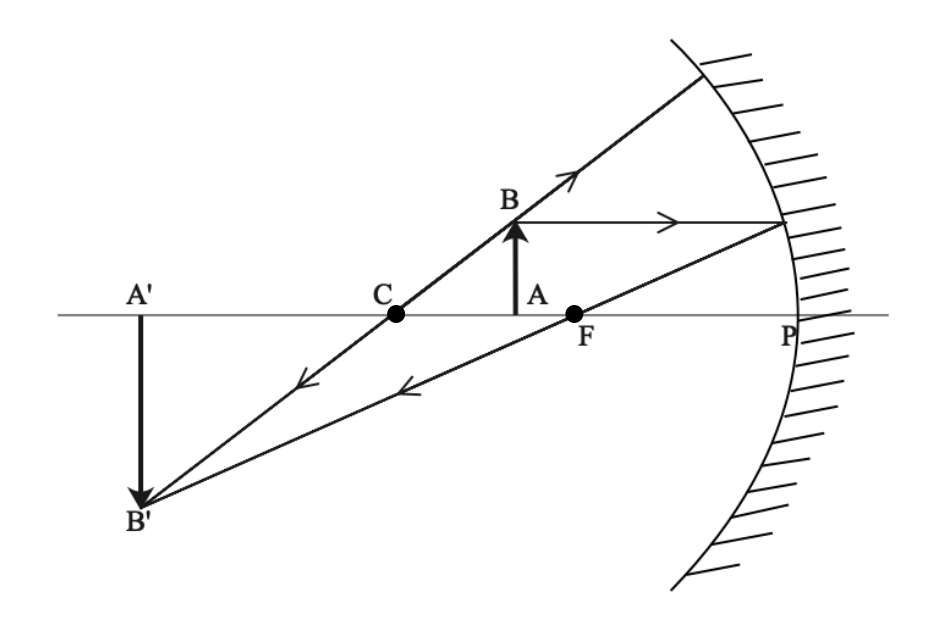
Draw a ray diagram for a concave mirror when the object is between the center of curvature and focus.
Answer
585k+ views
Hint:Center of curvature is twice as far as the focus of the concave mirror. Any light ray passing through the center of curvature will fall on the spherical surface in a perpendicular manner. Any light ray parallel to the principal axis will pass through the focus after reflection.
Complete step by step solution:
It is given that the object is kept between the center of curvature and focus.
We know that the radius of curvature is twice the focal length. Hence, we can place the object between the focus and center of curvature like we can see in the diagram.

First, draw a light ray passing through the center of curvature of the spherical surface. Any light passing through the center of curvature will fall on the spherical surface in a perpendicular manner. As a result, the light will trace back it’s the path. The BCB’ shows the path of the light ray in the diagram.
From the definition of the focus, we can say that any light, parallel to the principal axis, will go through the focus of the spherical surface after reflection. Hence, draw a light ray that is parallel to the principal axis. The light ray will pass through the focus of the spherical mirror after reflection.
The image of point B will be the point where these two light rays meet. In this case, the point is B’. So, A’B’ is the image of AB. As we can see, the image is real, inverted, and magnified.
Note:The same problem can be solved using the mirror formula. However, the process will take more calculation and mathematical manipulation. This solution uses the properties of spherical surfaces, and thereby, making the solution easy and universal.
Complete step by step solution:
It is given that the object is kept between the center of curvature and focus.
We know that the radius of curvature is twice the focal length. Hence, we can place the object between the focus and center of curvature like we can see in the diagram.

First, draw a light ray passing through the center of curvature of the spherical surface. Any light passing through the center of curvature will fall on the spherical surface in a perpendicular manner. As a result, the light will trace back it’s the path. The BCB’ shows the path of the light ray in the diagram.
From the definition of the focus, we can say that any light, parallel to the principal axis, will go through the focus of the spherical surface after reflection. Hence, draw a light ray that is parallel to the principal axis. The light ray will pass through the focus of the spherical mirror after reflection.
The image of point B will be the point where these two light rays meet. In this case, the point is B’. So, A’B’ is the image of AB. As we can see, the image is real, inverted, and magnified.
Note:The same problem can be solved using the mirror formula. However, the process will take more calculation and mathematical manipulation. This solution uses the properties of spherical surfaces, and thereby, making the solution easy and universal.
Recently Updated Pages
Master Class 12 Business Studies: Engaging Questions & Answers for Success

Master Class 12 Economics: Engaging Questions & Answers for Success

Master Class 12 English: Engaging Questions & Answers for Success

Master Class 12 Maths: Engaging Questions & Answers for Success

Master Class 12 Social Science: Engaging Questions & Answers for Success

Master Class 12 Chemistry: Engaging Questions & Answers for Success

Trending doubts
What are the major means of transport Explain each class 12 social science CBSE

Which are the Top 10 Largest Countries of the World?

Draw a labelled sketch of the human eye class 12 physics CBSE

Explain sex determination in humans with line diag class 12 biology CBSE

The pH of the pancreatic juice is A 64 B 86 C 120 D class 12 biology CBSE

Give 10 examples of unisexual and bisexual flowers




